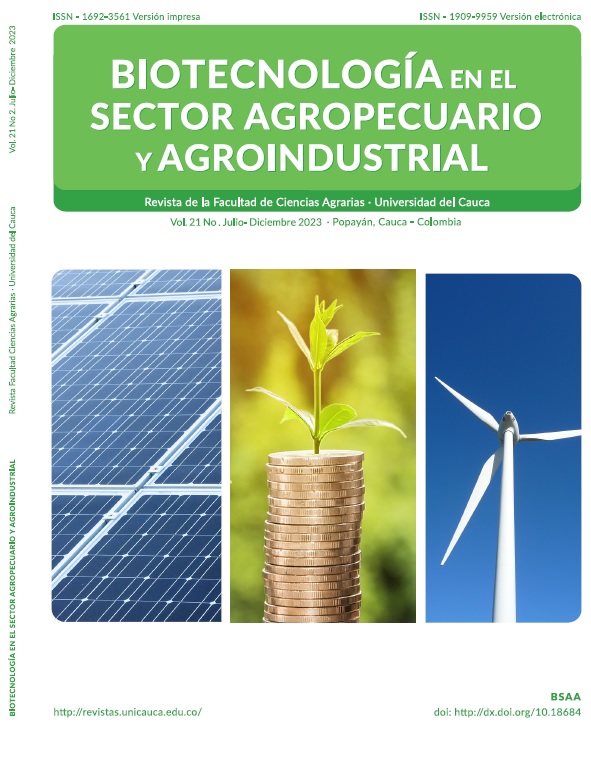Características fisicoquímicas y composición de ácidos grasos de aceites de calabaza,zapallo ysoya,duranteeltratamiento térmico
Resumen
Resumen
Los aceites vegetales son componentes importantes en la alimentación humana y debido a sus componentes dependiendo de su origen y tipo de procesamiento están relacionadas con la salud. El objetivo de esta investigación es realizar un estudio comparativo del comportamiento de los aceites de semilla de calabaza y semilla de zapallo cuando son sometidas a tratamiento térmico en relación a un aceite comercial. Para este propósito se han obtenido los aceites de las semillas de zapallo y calabaza, mediante extracción con C02 supercrítico y el aceite comercial fue el de soya obtenido del mercado local. Estos aceites se sometieron a un tratamiento térmico a diferentes temperaturas (20°C, 120°C, 150°C, 180°C y 200°C) luego a un tratamiento térmico a 180°C a diferentes tiempos de calentamiento (0 min, 10 min, 30 min, 60 min y 120 min), en cada caso se determinaron sus características fisicoquímicas (Índice de acidez, Índice de peróxidos, Índice de refracción y compuestos polares) y para la determinación de ácidos grasos esenciales se sometieron a tratamiento térmico hasta 240°C. Se encontró diferencias significativas los parámetros fisicoquímicos y contenido de ácidos grasos en los tres aceites, el aceite de soya presenta mejor estabilidad de su calidad fisicoquímica (Índice de acidez e índice de peróxidos) hasta 150°C, los aceites de semilla de calabaza y zapallo presentan estabilidad hasta 120°C, los compuestos polares a 180°C x 120 minutos presentan porcentajes de 13,5% en soya, 16% en zapallo y 15,5% en calabaza, los ácidos grasos en los tres aceites (a 240°C) presentan disminución en los insaturados e incremento en los saturados. Se concluye que los aceites de semilla de calabaza y zapallo son menos estables que el aceite comercial, se recomienda que su consumo debe realizarse en frio o máximo a 120°C para garantizar su calidad consumible.
Descargas
Disciplinas:
Alimentos funcionales, ciencia y tecnología de alimentosLenguajes:
Español; CastellanoReferencias bibliográficas
ABDULKARIM, S.M.; LONG, K.; LAI, O.M.; MUHAMMAD, S.K.; GHAZALI, H.M. Frying quality and stability of high-oleic Moringa oleifera seed oil in comparison with other vegetable oils. Food Chemistry, v. 105 n. 4, 2007, p. 1382–1389.https://doi.org/10.1016/j.foodchem.2007.05.013
AKIN, G.; ARSLAN, F.N.; KARUK-ELMAS, S.N.; YILMAZ, I. Cold-pressed pumpkin seed (Cucurbita pepo L.) oils from the central Anatolia region of Turkey: Characterization of phytosterols, squalene, tocols, phenolic acids, carotenoids and fatty acid bioactive compounds. Grasas y aceites, v. 69, 2018, p. 1–12. https://doi.org/10.3989/gya.0668171
ALHIBSHI, EMHEMMED A.; IBRAHEIM, JALAL A.; HADAD, ABDULGADER S. Effect of Heat Processing and Storage on Characteristic and Stability of Some Edible Oils. 6th Int’l Conference on Agriculture, Environment and Biological Sciences (ICAEBS) 16, 2016, p. 105–109.https://doi.org/10.15242/iie.a1216008
AOCS (American Oil Chemists' Society, Estados Unidos de América) Cd 3d-63. Acid value of fats and oils. In: Official Methods and Recommended Practices of the AOCS. 5th ed. Champaign, Illinois, USA: AOCS; 2009.
AOCS (American Oil Chemists' Society, Estados Unidos de América) Cd 8-53. Peroxide value. In: Official Methods and Recommended Practices of the AOCS. Champaign, Illinois, USA: AOCS; 2003.
AOCS (American Oil Chemists' Society, Estados Unidos de América) Tp 1a-64. Refractive index value of fats and oils. In: Official Methods and Recommended Practices of the AOCS. 5th ed. Champaign, Illinois, USA: AOCS; 2009.
BHAT, S.; MAGANJA, D.; HUANG, L.;WU, J.H.Y.; MARKLUND, M. Influence of Heating during Cooking on Trans Fatty Acid Content of Edible Oils: A Systematic Review and Meta-Analysis. Nutrients 2022, 14, 1489. https://doi.org/10.3390/nu14071489
BASTOS-FERNANDES, JULIO-CESAR; FERRANTE-DRAGHI, PATRICIA. Thermal Stability of Soybean Oil: When must we discard it? MOJ Food Processing & Technology, v. 2, n. 5, 2016, p. 1-5. https://doi.org/10.15406/mojfpt.2016.02.00051
BEN-HAMMOUDA, IBTISSEM; TRIKI, MEHDI; MATTHÄUS, BERTRAND; BOUAZIZ, MOHAMED. A Comparative Study on Formation of Polar Components, Fatty Acids and Sterols during Frying of Refined Olive Pomace Oil Pure and Its Blend Coconut Oil. Journal of Agricultural and Food Chemistry, v. 66, n. 13, 2018, p. 3514–3523.https://doi.org/10.1021/acs.jafc.7b05163
BERNARDO-GIL, M. GABRIELA; CARDOSO-LOPES, LINA M. Supercritical fluid extraction of Cucurbita ficifolia seed oil. European Food Research and Technology, v. 219, n. 6, 2004, p. 593–597. https://doi.org/10.1007/s00217-004-0978-2
BRESSANI, RICARDO. Caracterización química y nutricional de la semilla, pulpa y cáscara de chilacayote (Cucúrbita ficifolia) y aplicaciones en el desarrollo de productos. Consejo Nacional De Ciencia Y Tecnología (CONCYT), Secretaria Nacional de Ciencia y Tecnología (SENACYT), Fondo Nacional De Ciencia Y Tecnología (FONACYT), Universidad Del Valle De Guatemala, n. 023, 2015.
CHENG, M.H.; DIEN, B.S.; SINGH, V. Economics of plant oil recovery: A review. Biocatal. Agric. Biotechnol. 2019, 18, 101056.
CHEN, WEI-AN; CHIU, CHIHWEI P.; CHENG, WEI-CHIH; HSU, CHAO-KAI; KUO, MENG I. Total polar compounds and acid values of repeatedly used frying oils measured by standard and rapid methods. Journal of Food and Drug Analysis, v. 21, n. 1, 2013, p. 58–65.https://doi.org/10.6227/jfda.2013210107
DE ALZAA, F.; GUILLAUME, C.; RAVETTI, L. Evaluation of Chemical and Physical Changes in Different Commercial Oils during Heating. Acta Scientific Nurtitional Health, v. 2, 2018, p. 2–11.
DEL VALLE, J.M. Extraction of natural compounds using supercritical CO2: Going from the laboratory to the industrial application. J. Supercrit. Fluids 2015, 96, 180–199
DUBA, KURABACHEW-SIMON; FIORI, LUCA. Supercritical CO2 extraction of grape seed oil: Effect of process parameters on the extraction kinetics. The Journal of Supercritical Fluids, v. 98, 2015, p. 33–43. https://doi.org/10.1016/j.supflu.2014.12.021
FREIRE-MENDOÇA, POLIANA-CRISTINA; MANCINI-FILHO, JORGE; PINTO-DE CASTRO-FERREIRA, TANIA-APARECIDA. Principais alterações físico-químicas em óleos e gorduras submetidos ao processo de fritura por imersão: Regulamentação e efeitos na saúde. Revista de Nutricao, v. 26, n. 3, 2013, p. 353–358.https://doi.org/10.1590/S1415-52732013000300010
KUMAR, S.P.J.; PRASAD, S.R.; BANERJEE, R.; AGARWAL, D.K.; KULKARNI, K.S.; RAMESH, K.V. Green solvents and technologies for oil extraction from oilseeds. Chem. Cent. J. 2017, 11, 1–7.
LI, Y.; FINE, F.; FABIANO-TIXIER, A.S.; ABERT-VIAN, M.; CARRE, P.; PAGES, X.; CHEMAT, F. Evaluation of alternative solvents for improvement of oil extraction from rapeseeds. Comptes Rendus Chim. 2014, 17, 242–251.
MONTESANO, DOMENICO; BLASI, FRANCESCA; SIMONETTI, MARIA-STELLA; SANTINI, ANTONELLO; COSSIGNANI, LINA. Chemical and nutritional characterization of seed oil from Cucurbita maxima L. (Var. Berrettina) pumpkin. Foods, v. 7, n. 3, 2018, p. 1-14.https://doi.org/10.3390/foods7030030
NAVAS H., P.B.; FREGAPANE G.; SALVADOR, A. Quality indexes, mayor and minor constituents and oxidative stability of sesame and soybean virgin oils. Revista de La Facultad de Agronomia, Universidad del Zulia, v. 30, n. 2, 2013. p. 284–303.
NAYAK, PRAKASH-KUMAR; DASH, UMA; RAYAGURU, KALPANA; KRISHNAN, KEASVAN-RADHA. Physio-Chemical Changes During Repeated Frying of Cooked Oil: A Review. Journal of Food Biochemistry, v. 40, n. 3, 2016, p. 371–390.https://doi.org/10.1111/jfbc.12215
NAZIRI, ELENI; MITIĆ, MILAN N.; TSIMIDOU, MARIA Z. Contribution of tocopherols and squalene to the oxidative stability of cold-pressed pumkin seed oil (Cucurbita pepo L.). European Journal of Lipid Science and Technology, v. 118, n. 6, 2016. p. 898–905.https://doi.org/10.1002/ejlt.201500261
NORMA SANITARIA PARA EL FUNCIONAMIENTO DE RESTAURANTES Y SERVICIOS AFINES. Lima (Perú): Ministerio de Salud (MINSA), Resolución Ministerial Nº 965-2014/MINSA, 2014.
PATEL, SEEMA; RAUF, ABDUR. Edible seeds from Cucurbitaceae family as potential functional foods: Immense promises, few concerns. Biomedicine and Pharmacotherapy, v. 91, 2017, p. 330–37.https://doi.org/10.1016/j.biopha.2017.04.090
PETKOVA, ZHANA; ANTOVA, GINKA. A comparative study on quality parameters of pumpkin, melon and sunflower oils during thermal treatment. OCL - Oilseeds and Fats, Crops and Lipids, v. 26, 2019, p. 5-8. https://doi.org/10.1051/ocl/2019028
PULGAR-VIDAL J. Geografía del Perú: Las Ocho Regiones Naturales del Perú. Lima, Perú: Universo SA, 1979. 145-161. ISBN 9972-58-007-5
REZIG LEILA, CHOUAIBI MONCEF, OJEDA-AMADOR ROSA MARIA, GOMEZ-ALONSO SERGIO, SALVADOR MARIA DESAMPARADOS, FREGAPANE GIUSEPPE, HAMDI SALEM. Cucurbita maxima Pumpkin Seed Oil: from the Chemical Properties to the Different Extracting Techniques. Not Bot Horti Agrobo, 2018, 46(2):663-669
ROSARIO-LEON, PAUL-HERS. Efecto protector de la almendra de semillas de Cucurbita ficifolia Bouché (calabaza blanca) en el daño hepático inducido por paracetamol en ratones [Tesis de LIcenciado en Nutrición]. Lima (Perú): Universidad Nacional Mayor de San Marcos. Perú. Facultad de Medicina, 2019, 52 p.
SMIGIC, N.; DJEKIC, I.; TOMIC, N.; UDOVICKI, B.; RAJKOVIC, A. The potential of foods treated with supercritical carbon dioxide (SCO2) as novel foods. Br. Food J. 2019, 121, 815–834.
STEVENSON, DAVID G.; ELLER, FRED J.; WANG, LIPING; JANE, JAY-LIN; WANG, TONG; INGLETT, GEORGE E. Oil and tocopherol content and composition of pumpkin seed oil in 12 cultivars. Journal of Agricultural and Food Chemistry, v. 55, n. 10, 2007, p. 4005–4013.https://doi.org/10.1021/jf0706979
UBA, B.; MUHAMMAD, C. Determination of Fatty Acid Composition and Physicochemical Properties of Cucurbita Maxima (Pumpkin) Seed Oil cultivated in northeast Nigeria. East African Scholars Multidisciplinary Bulletin, v. 4413, n. 7, 2019. p. 231–234.https://doi.org/10.36349/easmb.2019.v02i08.009
VALERIE M. LAVENBURG, KURT A. Rosentrater and Stephanie Jung. Extraction Methods of Oils and Phytochemicals from Seeds and Their Environmental and Economic Impacts. Processes. 2021, 9, 1839.
YAGUE-AYLON, MARIA-ANGELES. Estudio de utilización de aceites para fritura en establecimientos alimentarios de comidas preparadas. Observacion De La Seguretat, v. 2, 2003, p. 1–34http://avdiaz.files.wordpress.com/2008/08/mangeles-aylon-blog.pdf
YE, X.; XUE, S.J.; SHI, J. Green separation technology in food processing: Supercritical-CO2 fluid extraction. In Advances in Food Processing Technology; Jia, J., Liu, D., Ma, H., Eds.; Springer: Singapore, 2019; pp. 73–99.
Derechos de autor 2023 Universidad del Cauca

Esta obra está bajo una licencia internacional Creative Commons Atribución-NoComercial-SinDerivadas 4.0.


 Español
Español Inglés
Inglés





















.png)



